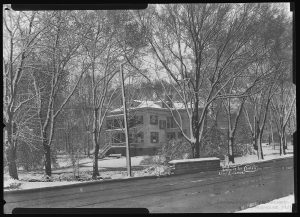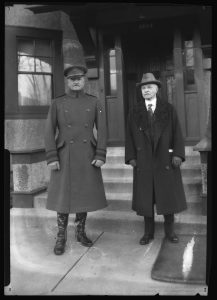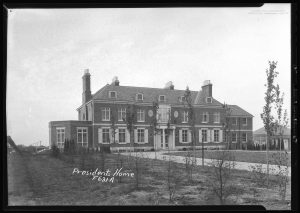For this week’s Tales from the Nitrate Negatives, please humor us for a bit as we engage in a bit of train-based role play:
Imagine with for a second that it’s the early spring, 1947 and you’re finishing up a long train journey back to Champaign from Chicago. It’s a quaint Saturday morning and you’ve been expecting a relaxing ride home after a week working in the city. As you start to see the oh-so familiar corn and soybean fields flying past as your 100 mile per hour ride is whizzing through the state. As the image of farmers riding by in tractors is starting to get a tad monotonous, you feel the train slightly lurch. Thankfully, you know this feeling well. It’s a totally normal feeling just before the train starts to decelerate on the trip into town. You feel that slightly thicker air drag on you as the body of the train begins slowing down, but you still have so much inertia dragging you forward. It’s a nice feeling, but you feel it a tad more intense than usual. Moments after that first lurch, the train lurches again. Before you can even question it, you hear the screeching wail of steel scraping against steel and you see sparks an iron go flying past these former farm-filled windows. Your cabin lurches one last time, harder than before. The rapid compression causes the windows to all shatter around you as your body is hurled over your diner car table. There is a brief moment where you are unbound by gravity just before you’re hurled headfirst into a silverware cart; your 1947 brain wonders “How in the world did some yuck, geezer, cold fish, chicken, chrome dome, 1940’s slang, train conductor just crash this train?!”. Everything goes black. You get flits of the fiery and wicked scene as you’re dragged out of the train by rescue crews and taken to a local hospital for injuries. The next morning, lying in a Champaign hospital, you check the day’s newspaper. You read that your train somehow jumped a track injuring 197 and killing 2 people. Just before the, likely over-prescribed, morphine kicks in, you ask the question, “What in the world could have happened to this train?”
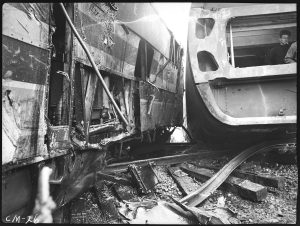
Well, the story of the City of Miami Streamliner is a graphic, yet interesting tale. On Saturday April 19th, train conductor Charles H. Redus noticed that the remote-control track switch meant to bring his train into into Champaign was hasn’t been flipped. In his reports to the investigators just before his passing, Redus noted that he’d seen a green light shine on the switch relay. While that traditionally meant he was clear to go, he saw from the front of the train that the switch itself had not actually flipped. He did his best to slow the train down in the 300 feet before the incoming disaster, but it was too late. The train hit the switch, jumped the track, and rolled itself off the train tracks. The Champaign News-Gazette of April 20, 1947, reports that it tore up more than a quarter mile of track as the entire streamliner “went up in a nest of steel and a ball of flame.” On April 27th, a Daily Illini Article reported on an investigation by Amtrak and city officials. Their results found that an improper installation of electrical relays on the track was the culprit. Two relays, installed the morning just before the wreck occurred, were incorrectly installed. The signal was mistakenly inverted. So, when it was meant to flash yellow and signal to slow down, it shined green, and vice versa. If it weren’t for Redus’ keen eyes of the track itself, this mistaken relay could have brought the train full force into the crash zone. Just a simple electrical mistake that brought this 85 mile per hour (136 KMpH) missile of a train flying off the tracks into a ripped steel, diesel fireball.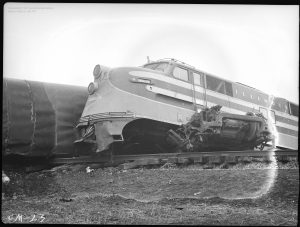
 Despite the coalescence of mistakes, the casualty numbers were thankfully very low. Initial reports said 197 people were injured, but the number was lowered to 107 by the 20th with only 32 hospitalized. The 2 casualties of the accident were the two men at the further points front and back of the train. The final car’s bagman, Charles N. Wood, and the engineer, Charles H. Redus, were the only people who lost their lives as a result of the crash. Many reports note that the tables bolted to the floor and chars adhered to the walls prevented massive structures from crushing people throughout the train. The bagman, Charles Wood, was killed instantly. The lurches of the train and the collapse of the final car brought the bagging compartment crashing down on him. An eyewitness to the bag car reported that Wood was crushed by the luggage instantly and he couldn’t save him. The conductor, Charles Redus, was thrust into the control panel and his leg was badly injured. In a report from the April 25th Daily Illini, a passenger that rushed to his aid had to apply a tourniquet to his leg to stop the bleeding. Ambulances arrived 15 minutes after the crash when two different farmers plowing their nearby fields witnessed the explosion. The blast and sounds could be heard for miles and the response was thankfully almost instantaneous.
Despite the coalescence of mistakes, the casualty numbers were thankfully very low. Initial reports said 197 people were injured, but the number was lowered to 107 by the 20th with only 32 hospitalized. The 2 casualties of the accident were the two men at the further points front and back of the train. The final car’s bagman, Charles N. Wood, and the engineer, Charles H. Redus, were the only people who lost their lives as a result of the crash. Many reports note that the tables bolted to the floor and chars adhered to the walls prevented massive structures from crushing people throughout the train. The bagman, Charles Wood, was killed instantly. The lurches of the train and the collapse of the final car brought the bagging compartment crashing down on him. An eyewitness to the bag car reported that Wood was crushed by the luggage instantly and he couldn’t save him. The conductor, Charles Redus, was thrust into the control panel and his leg was badly injured. In a report from the April 25th Daily Illini, a passenger that rushed to his aid had to apply a tourniquet to his leg to stop the bleeding. Ambulances arrived 15 minutes after the crash when two different farmers plowing their nearby fields witnessed the explosion. The blast and sounds could be heard for miles and the response was thankfully almost instantaneous.
Within the hour, wrecking crews, garbage train cars, and Strauch himself were on scene. The images of these collection were taken around 15:00 when the wreck itself occurred at 13:15. His images capture both the astonishment of investigators, the shock on the eyes of the rescued passengers, and the grim visages of the wrecking crews. While one wouldn’t expect a series of just 31 images about a train crash to carry such emotion, Strauch captured the grueling ambiance of the scene. Gray clouds had rolled in, and the sheer carnage of a vehicle formerly so pristine is intense.
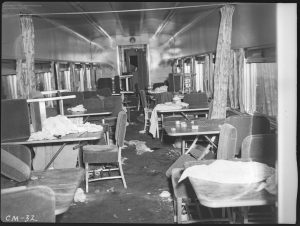
The speed at which Strauch arrived on scene allowed for history to be captured when it could have been just as easily lost to time. Almost a century later we can look back on a story so well preserved in the heart of these images. It makes us reflect on what images of the modern day tragedies we face will persevere, and what stories will be told of those caught in our versions of the train wreck? We approach a century since Strauch’s first pictures were taken, yet we still deal with the same feelings of loss and the same accidents that beget tragedy. So, the burden placed on us all is to think of how we can learn from the past to venerate those lost in the present.

